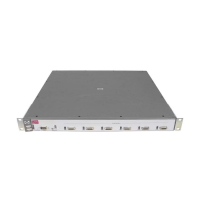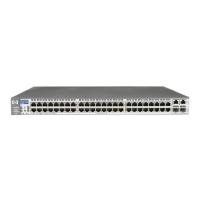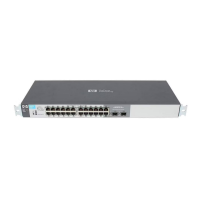Troubleshooting
Using the Event Log for Troubleshooting Switch Problems
System
Module
Description
Documented in ProCurve Hardware/
Software guide
cos
dca
dhcp
dhcp v6c
download
dma
fault
ffi
garp
gvrp
hpesp
idm
igmp
Class of Service (CoS): Provides priority handling of packets
traversing the switch, based on the IEEE 802.1p priority carried
by each packet.
CoS messages also include Quality of Service (QoS) events.
The QoS feature classifies and prioritizes traffic throughout a
network, establishing an end-to-end traffic priority policy to
manage available bandwidth and improve throughput of
important data.
Dynamic Configuration Arbiter (DCA) determines the client-
specific parameters that are assigned in an authentication
session.
Dynamic Host Configuration Protocol (DHCP) server
configuration: Switch is automatically configured from a
DHCP (Bootp) server, including IP address, subnet mask,
default gateway, Timep Server address, and TFTP server
address.
DHCP for IPv6 prefix assignment
Download operation for copying a software version or files to
the switch.
Direct Access Memory (DMA): Transmits and receives
packets between the CPU and the switch.
Fault Detection facility, including response policy and the
sensitivity level at which a network problem should generate
an alert.
Find, Fix, and Inform: Event or alert log messages indicating a
possible topology loop that cause excessive network activity
and results in the network running slow. FFI messages include
events on transceiver connections with other network
devices.
Generic Attribute Registration Protocol (GARP), defined in the
IEEE 802.1D-1998 standard.
GARP VLAN Registration Protocol (GVRP): Manages dynamic
802.1Q VLAN operations, in which the switch creates
temporary VLAN membership on a port to provide a link to
another port in the same VLAN on another device.
Management module that maintains communication between
switch ports.
Identity-driven Management: Optional management
application used to monitor and control access to switch.
Internet Group Management Protocol: Reduces unnecessary
bandwidth usage for multicast traffic transmitted from
multimedia applications on a per-port basis.
Advanced Traffic Management Guide
Access Security Guide
Management and Configuration Guide
IPv6 Configuration Guide
Management and Configuration Guide
—
Management and Configuration Guide
Installation and Getting Started Guide
Management and Configuration Guide
Advanced Traffic Management Guide
Advanced Traffic Management Guide
Installation and Getting Started Guide
Advanced Traffic Management Guide
Multicast and Routing Guide
C-26

